DRAG DROP -
You use GitHub Enterprise Server as a source code repository.
You create an Azure DevOps organization named Contoso.
In the Contoso organization, you create a project named Project1.
You need to link GitHub commits, pull requests, and issues to the work items of Project1. The solution must use OAuth-based authentication.
Which three actions should you perform in sequence? To answer, move the appropriate actions from the list of actions to the answer area and arrange them in the correct order.
Select and Place: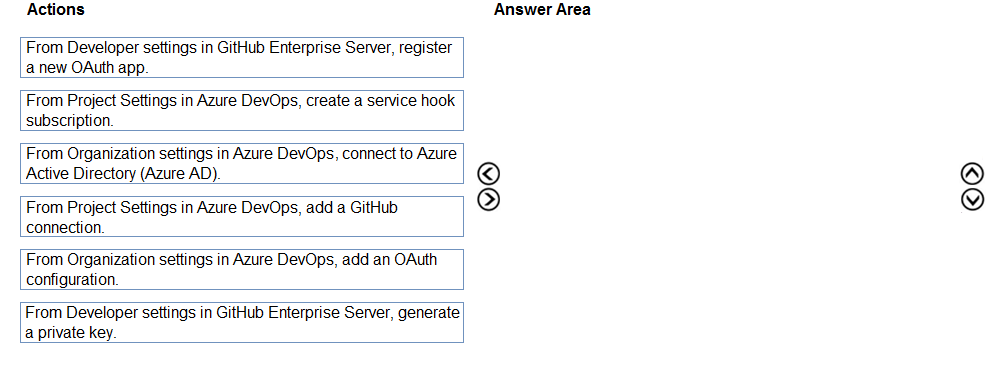
Answer:
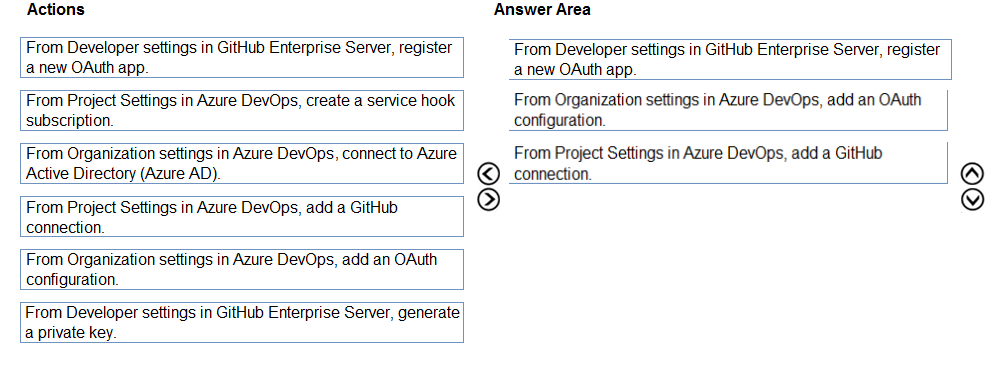
Step 1: From Developer settings in GitHub Enterprise Server, register a new OAuth app.
If you plan to use OAuth to connect Azure DevOps Services or Azure DevOps Server with your GitHub Enterprise Server, you first need to register the application as an OAuth App
Step 2: Organization settings in Azure DevOps, add an OAuth configuration
Register your OAuth configuration in Azure DevOps Services.
Note:
1. Sign into the web portal for Azure DevOps Services.
2. Add the GitHub Enterprise Oauth configuration to your organization.
3. Open Organization settings>Oauth configurations, and choose Add Oauth configuration.
4. Fill in the form that appears, and then choose Create.
Step 3: From Project Settings in Azure DevOps, add a GitHub connection.
Connect Azure DevOps Services to GitHub Enterprise Server
Choose the Azure DevOps logo to open Projects, and then choose the Azure Boards project you want to configure to connect to your GitHub Enterprise repositories.
Choose (1) Project Settings, choose (2) GitHub connections and then (3) Click here to connect to your GitHub Enterprise organization.
Reference:
https://docs.microsoft.com/en-us/azure/devops/boards/github/connect-to-github
DRAG DROP -
You are configuring an Azure DevOps deployment pipeline. The deployed application will authenticate to a web service by using a secret stored in an Azure key vault.
You need to use the secret in the deployment pipeline.
Which three actions should you perform in sequence? To answer, move the appropriate actions from the list of actions to the answer area and arrange them in the correct order.
Select and Place: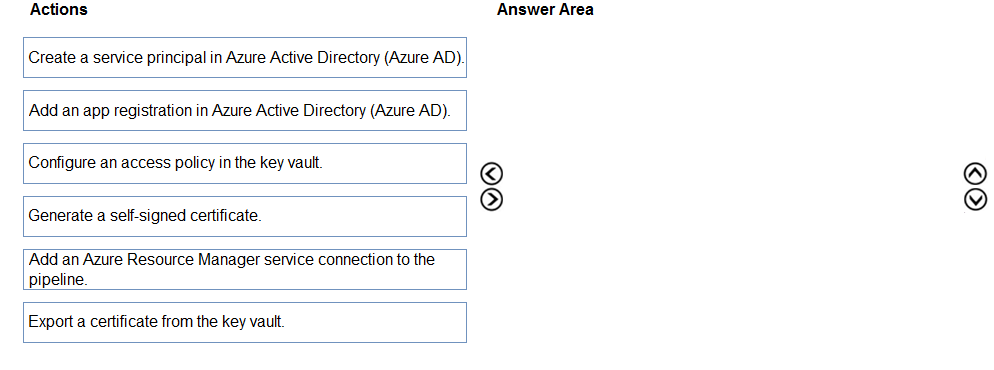
Answer:
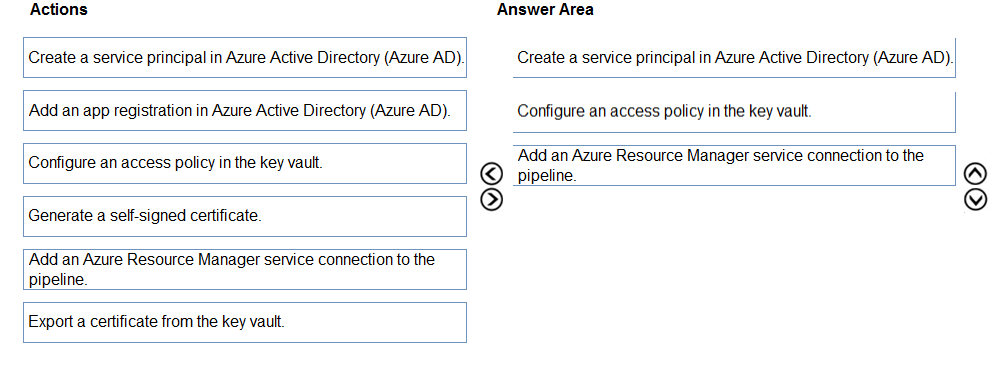
Step 1: Create a service principal in Azure Active Directory (Azure AD).
You will need a service principal to deploy an app to an Azure resource from Azure Pipelines.
Step 2: Configure an access policy in the key vault.
You need to secure access to your key vaults by allowing only authorized applications and users. To access the data from the vault, you will need to provide read
(Get) permissions to the service principal that you will be using for authentication in the pipeline.
Select Access policy and then select + Add Access Policy to setup a new policy.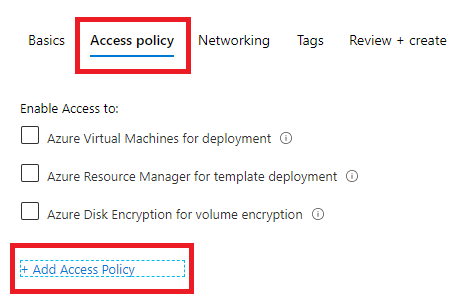
Step 3: Add an Azure Resource Manager service connection to the pipeline
You need to authorize the pipeline to deploy to Azure:
1. Select Pipelines | Pipelines,
2. Go to Releases under Pipelines and then select and Edit your pipeline.
3. Under Tasks, notice the release definition for Dev stage has a Azure Key Vault task. This task downloads Secrets from an Azure Key Vault. You will need to point to the subscription and the Azure Key Vault resource.
4. Click Manage, this will redirect to the Service connections page.
5.Click on New Service connection -> Azure Resource Manager -> Service Principal (manual). Fill the information from previously created service principal.
Reference:
https://azuredevopslabs.com/labs/vstsextend/azurekeyvault/
DRAG DROP -
You have a private project in Azure DevOps and two users named User1 and User2.
You need to add User1 and User2 to groups to meet the following requirements:
✑ User1 must be able to create a code wiki.
✑ User2 must be able to edit wiki pages.
✑ The solution must use the principle of least privilege.
To which group should you add each user? To answer, drag the appropriate groups to the correct users. Each group may be used once, more than once, or not at all. You may need to drag the split bar between panes or scroll to view content.
NOTE: Each correct selection is worth one point.
Select and Place:
Answer:

User1: Project Administrators -
You must have the permission Create Repository to publish code as wiki. By default, this permission is set for members of the Project Administrators group.
User2: Contributors -
Anyone who is a member of the Contributors security group can add or edit wiki pages.
Anyone with access to the team project, including stakeholders, can view the wiki.
Reference:
https://docs.microsoft.com/en-us/azure/devops/project/wiki/wiki-create-repo
You use WhiteSource Bolt to scan a Node.js application.
The WhiteSource Bolt scan identifies numerous libraries that have invalid licenses. The libraries are used only during development and are not part of a production deployment.
You need to ensure that WhiteSource Bolt only scans production dependencies.
Which two actions should you perform? Each correct answer presents part of the solution.
NOTE: Each correct selection is worth one point.
Answer:
AC
A: To resolve NPM dependencies, you should first run "npm install" command on the relevant folders before executing the plugin.
C: All npm packages contain a file, usually in the project root, called package.json ג€" this file holds various metadata relevant to the project. This file is used to give information to npm that allows it to identify the project as well as handle the project's dependencies. It can also contain other metadata such as a project description, the version of the project in a particular distribution, license information, even configuration data ג€" all of which can be vital to both npm and to the end users of the package.
Reference:
https://whitesource.atlassian.net/wiki/spaces/WD/pages/34209870/NPM+Plugin https://nodejs.org/en/knowledge/getting-started/npm/what-is-the-file-package-json
Note: This question is part of a series of questions that present the same scenario. Each question in the series contains a unique solution that might meet the stated goals. Some question sets might have more than one correct solution, while others might not have a correct solution.
After you answer a question in this section, you will NOT be able to return to it. As a result, these questions will not appear in the review screen.
You plan to update the Azure DevOps strategy of your company.
You need to identify the following issues as they occur during the company's development process:
✑ Licensing violations
✑ Prohibited libraries
Solution: You implement continuous integration.
Does this meet the goal?
Answer:
A
WhiteSource is the leader in continuous open source software security and compliance management. WhiteSource integrates into your build process, irrespective of your programming languages, build tools, or development environments. It works automatically, continuously, and silently in the background, checking the security, licensing, and quality of your open source components against WhiteSource constantly-updated definitive database of open source repositories.
Reference:
https://azuredevopslabs.com/labs/vstsextend/whitesource/
Note: This question is part of a series of questions that present the same scenario. Each question in the series contains a unique solution that might meet the stated goals. Some question sets might have more than one correct solution, while others might not have a correct solution.
After you answer a question in this section, you will NOT be able to return to it. As a result, these questions will not appear in the review screen.
You plan to update the Azure DevOps strategy of your company.
You need to identify the following issues as they occur during the company's development process:
✑ Licensing violations
✑ Prohibited libraries
Solution: You implement pre-deployment gates.
Does this meet the goal?
Answer:
B
Instead use implement continuous integration.
Note: WhiteSource is the leader in continuous open source software security and compliance management. WhiteSource integrates into your build process, irrespective of your programming languages, build tools, or development environments. It works automatically, continuously, and silently in the background, checking the security, licensing, and quality of your open source components against WhiteSource constantly-updated definitive database of open source repositories.
Reference:
https://azuredevopslabs.com/labs/vstsextend/whitesource/
Note: This question is part of a series of questions that present the same scenario. Each question in the series contains a unique solution that might meet the stated goals. Some question sets might have more than one correct solution, while others might not have a correct solution.
After you answer a question in this section, you will NOT be able to return to it. As a result, these questions will not appear in the review screen.
You plan to update the Azure DevOps strategy of your company.
You need to identify the following issues as they occur during the company's development process:
✑ Licensing violations
✑ Prohibited libraries
Solution: You implement automated security testing.
Does this meet the goal?
Answer:
B
Instead use implement continuous integration.
Note: WhiteSource is the leader in continuous open source software security and compliance management. WhiteSource integrates into your build process, irrespective of your programming languages, build tools, or development environments. It works automatically, continuously, and silently in the background, checking the security, licensing, and quality of your open source components against WhiteSource constantly-updated definitive database of open source repositories.
Reference:
https://azuredevopslabs.com/labs/vstsextend/whitesource/
Note: This question is part of a series of questions that present the same scenario. Each question in the series contains a unique solution that might meet the stated goals. Some question sets might have more than one correct solution, while others might not have a correct solution.
After you answer a question in this section, you will NOT be able to return to it. As a result, these questions will not appear in the review screen.
You plan to update the Azure DevOps strategy of your company.
You need to identify the following issues as they occur during the company's development process:
✑ Licensing violations
✑ Prohibited libraries
Solution: You implement continuous deployment.
Does this meet the goal?
Answer:
B
Instead implement continuous integration.
Note: WhiteSource is the leader in continuous open source software security and compliance management. WhiteSource integrates into your build process, irrespective of your programming languages, build tools, or development environments. It works automatically, continuously, and silently in the background, checking the security, licensing, and quality of your open source components against WhiteSource constantly-updated definitive database of open source repositories.
Reference:
https://azuredevopslabs.com/labs/vstsextend/whitesource/
SIMULATION -
You manage a website that uses an Azure SQL Database named db1 in a resource group named RG1lod11566895.
You need to modify the SQL database to protect against SQL injection.
To complete this task, sign in to the Microsoft Azure portal.
Answer:
See explanation below.
Set up Advanced Threat Protection in the Azure portal
1. Sign into the Azure portal.
2. Navigate to the configuration page of the server you want to protect. In the security settings, select Advanced Data Security.
3. On the Advanced Data Security configuration page: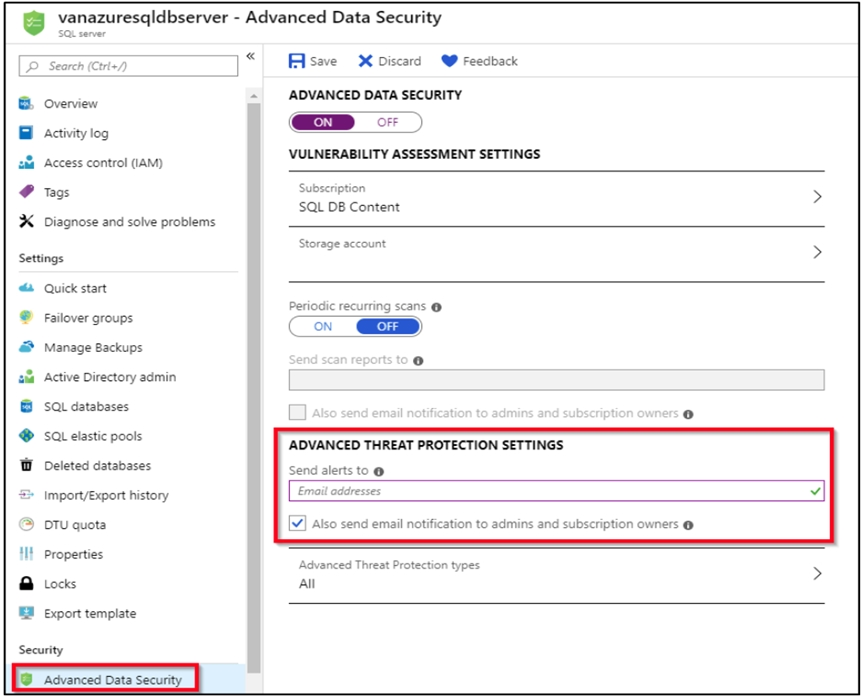
4. Enable Advanced Data Security on the server.
Note: Advanced Threat Protection for Azure SQL Database detects anomalous activities indicating unusual and potentially harmful attempts to access or exploit databases. Advanced Threat Protection can identify Potential SQL injection, Access from unusual location or data center, Access from unfamiliar principal or potentially harmful application, and Brute force SQL credentials
Reference:
https://docs.microsoft.com/en-us/azure/storage/common/storage-account-create https://docs.microsoft.com/en-us/azure/azure-sql/database/threat-detection-configure
HOTSPOT -
Your company has an Azure subscription.
The company requires that all resource groups in the subscription have a tag named organization set to a value of Contoso.
You need to implement a policy to meet the tagging requirement.
How should you complete the policy? To answer, select the appropriate options in the answer area.
NOTE: Each correct selection is worth one point.
Hot Area: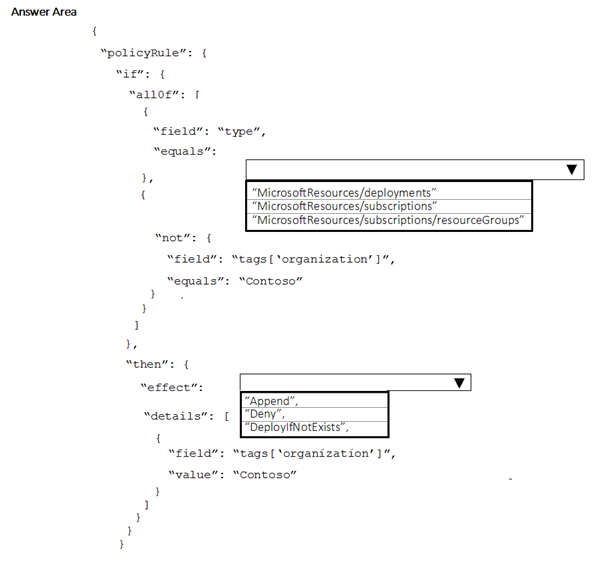
Answer:
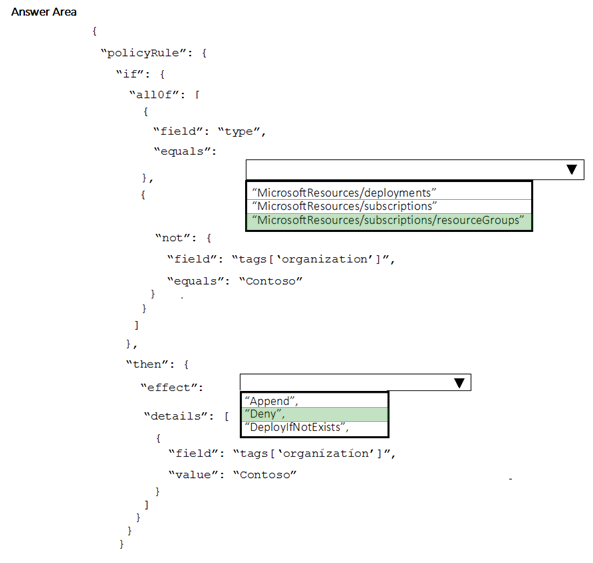
Box 1: " Microsoft.Resources/subscriptions/resourceGroups"
Box 2: "Deny",
Sample - Enforce tag and its value on resource groups
},
"policyRule": {
"if": {
"allOf": [
{
"field": "type",
"equals": "Microsoft.Resources/subscriptions/resourceGroups"
},
{
"not": {
"field": "[concat('tags[',parameters('tagName'), ']')]",
"equals": "[parameters('tagValue')]"
}
}
]
},
"then": {
"effect": "deny"
}
}
}
}
Reference:
https://docs.microsoft.com/en-us/azure/governance/policy/samples/enforce-tag-on-resource-groups